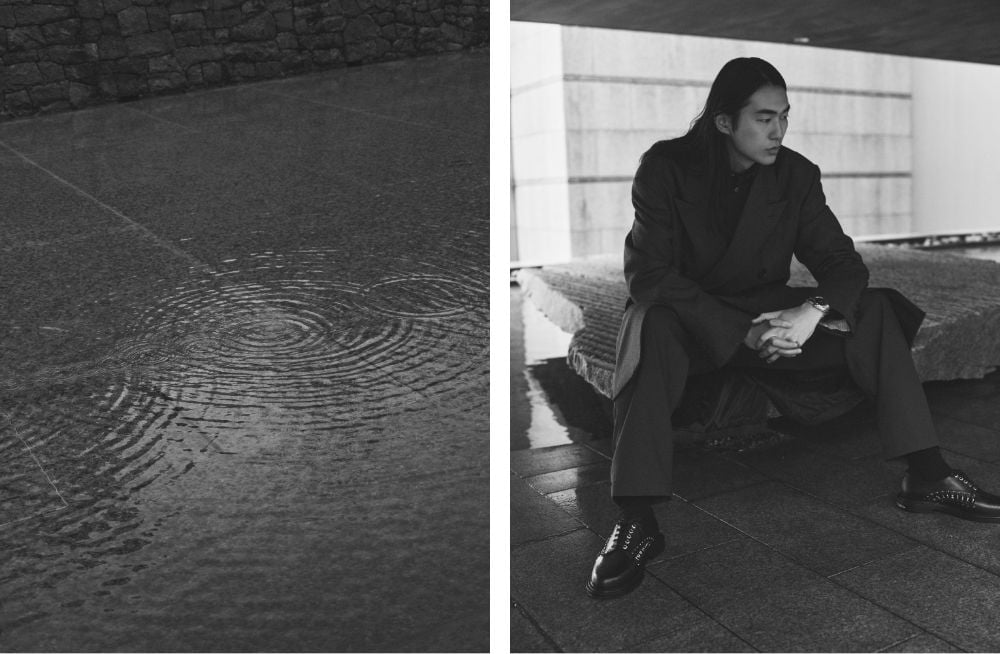Japanese aesthetic sense and craftsmanship.
The aesthetics of tradition and innovation continue to mark the passage of time around the world today.
Masterpiece architecture that symbolizes the expertise and aesthetic sense of Japan.
Emotional Tokyo cityscapes project peoples’ lives and a rich range of expressions.
Minimalism and functional beauty. Emotion and elegance.
Marking Tokyo time from the days of old into the future.
International photographer Josh Olins, whose work resonates with the aesthetics of Grand Seiko, captures images of modern Tokyo.
*****
The SLGA021 dial was inspired by a lake’s surface caressed by gentle breezes just before dawn.
Kiyosumi Shirakawa, a waterside district teeming with creativity, is awash in history and culture.
Its waterscape, conveying clear images of art, furnishes a handsome match for this part of the big city.
LOCATION
Museum of Contemporary Art Tokyo
-

The Museum of Contemporary Art Tokyo stands at the north edge of Kiba Park, a rich green space located in Tokyo’s Koto Ward. Besides the special exhibitions of creations by contemporary artists from both Japan and abroad, the museum is also celebrated for its regular rotation of a total of some 5,800 works. These creations provide a stimulating overview of the history of post-World War II Japanese art, grouped by various themes and subject matter.
While this is a charismatic gallery noted for its display space with its circular flow, it is also no exaggeration to state that the single greatest attraction of the structure lies in its open entrance hall. The late Takahiko Yanagisawa, the architect entrusted with its design, most certainly pondered how best to generate fluid visual connections spanning both the park and the museum, as well as between nature and art.One of the answers conceived by Yanagisawa as a solution to such queries was to design an entrance hall as a crossing between the boundary area of the museum and the park. More specifically, this hall, which stretches in a straight line and is covered with a glass wall stretching over the 140-meter width of the park, features special exhibition and collection display rooms. It functions as a channel leading to the museum shop, while likewise providing linkage with the rich green natural surroundings.
The building comprises three aboveground and two basement levels, and the three- story atrium, engineered to provide a stream of natural light, portrays the flow of time throughout the day, as well as the ever-shifting state of light and shadow. Two basement levels have varying ceiling heights of four, six and nine meters. This enables separate floors to handle a wide range of creations, with cutting-edge technology used in numerous locations throughout the structure. This distinctive space, truly ideal for the appreciation of modern art, is imbued with elegance worthy of the refined design and precision for which Grand Seiko is renowned.
-

Kiyosumi Gardens
Although Kiyosumi Gardens is situated in Koto Ward in the capital city, it is renowned for the encounters that visitors can experience with its rich range of seasonal flowers and wild birds.The area is structured as a so-called “strolling forest garden” with a large pond situated at the center – an approach adopted in the gardens of feudal lords from the Edo period of Japanese history (1603-1868). This style was carried on in the ensuing Meiji period, and is considered to have been further perfected and completed with its adoption in Kiyosumi Gardens.
In 1878, entrepreneur Yataro Iwasaki, founder of the Mitsubishi financial group, acquired the remains of a feudal residence on this site (spanning some 100,000 square meters). Water was drawn from the Sumida River to form a large pond, with famous stones gathered from around Japan placed on the grounds. The park was opened in 1880 under the name of “Fukagawa Shimbokuen” (Fukagawa Friendship Garden). The eastern half of the park, which suffered comparably limited damage in the Great Kanto Earthquake of 1923, was donated to Tokyo City the following year. That area was redeveloped and opened as Kiyosumi Gardens in 1932.
The Evolution 9 Collection SLGA021, whose dial changes in appearance based on the angle of light, portrays the motif of the surface of Lake Suwa in Nagano Prefecture caressed by gentle breezes just before dawn. The hushed flow of time overlaps with the ripples of the pond and the changing sunlight in Kiyosumi Garden, blessed with abundant natural beauty despite being located within the Tokyo metropolis.
Text by Taka Kawachi
-

-
SLGA021
Evolution 9 Collection
The SLGA021 is distinguished by a dial pattern portraying the image of the surface of Lake Suwa just before dawn. This body of water is located southeast of the Shinshu Watch Studio in Nagano Prefecture, home of Grand Seiko Spring Drive. The dark blue dial reflects the passage of time, and changes its character based on the angle at which it is struck by light, with exquisite expressions conjuring up images of the lake’s surface caressed by gentle breezes.
The SLGA021 is distinguished by a dial pattern portraying the image of the surface of Lake Suwa just before dawn. This body of water is located southeast of the Shinshu Watch Studio in Nagano Prefecture, home of Grand Seiko Spring Drive. The dark blue dial reflects the passage of time, and changes its character based on the angle at which it is struck by light, with exquisite expressions conjuring up images of the lake’s surface caressed by gentle breezes.
-
Photographer
Josh Olins

-
Born in London, Benelux, and currently based in New York, Olins excels in photography primarily seen in fashion ads and magazines. Famed for depictions rich in both strength and elegance, he enjoys a steady stream of offers from renowned magazines including VOGUE and many clients such as Louis Vuitton, Balenciaga, Calvin Klein, and Jil Sander.In the Japan Issue of Holiday Magazine, published in 2015, he earned keen attention for the inclusion of his Japan fashion editorial shoot extending throughout the entire issue.








